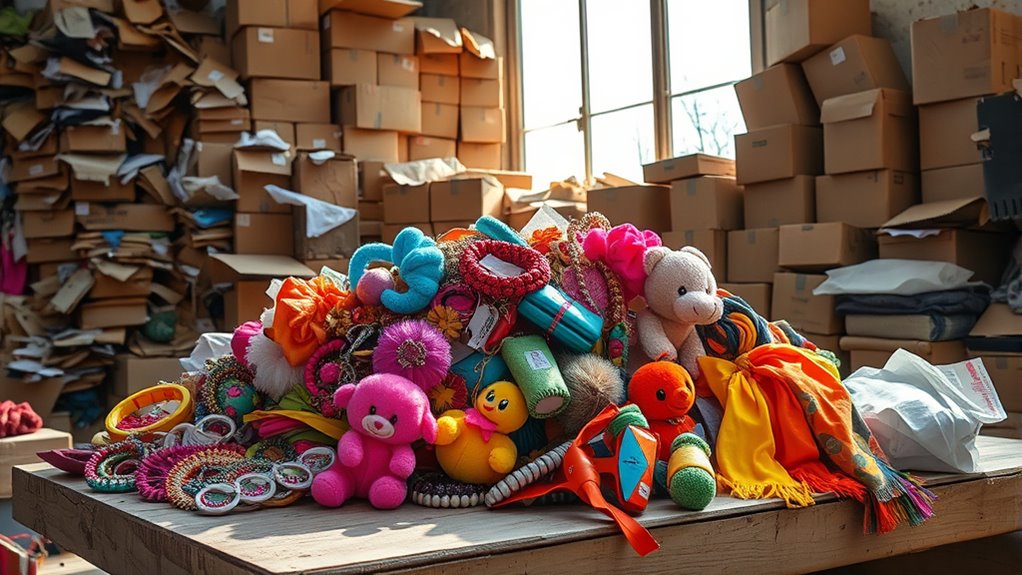Fast-fashion gift items harm the environment at every stage, from cheap, resource-intensive production to disposal. Manufacturing uses tons of water, fossil fuels, and toxic chemicals that pollute waterways and release microplastics into oceans. Low-quality gifts quickly end up in landfills, taking years to decompose. Your choices as a consumer influence this cycle—opting for sustainable options can reduce these impacts. Keep exploring to discover how you can make more eco-friendly gift decisions.
Key Takeaways
- Fast-fashion gifts rely on cheap, synthetic materials that release microplastics and toxic chemicals into ecosystems.
- Rapid production and poor labor practices contribute to environmental degradation and increased carbon emissions.
- Low-quality garments from fast fashion quickly become waste, adding to landfills and pollution.
- Manufacturing processes consume high energy and water, further elevating environmental footprints.
- Choosing sustainable gifts reduces demand for fast fashion, decreasing resource depletion and environmental harm.
The Lifecycle of Fast-Fashion Gifts: From Production to Disposal
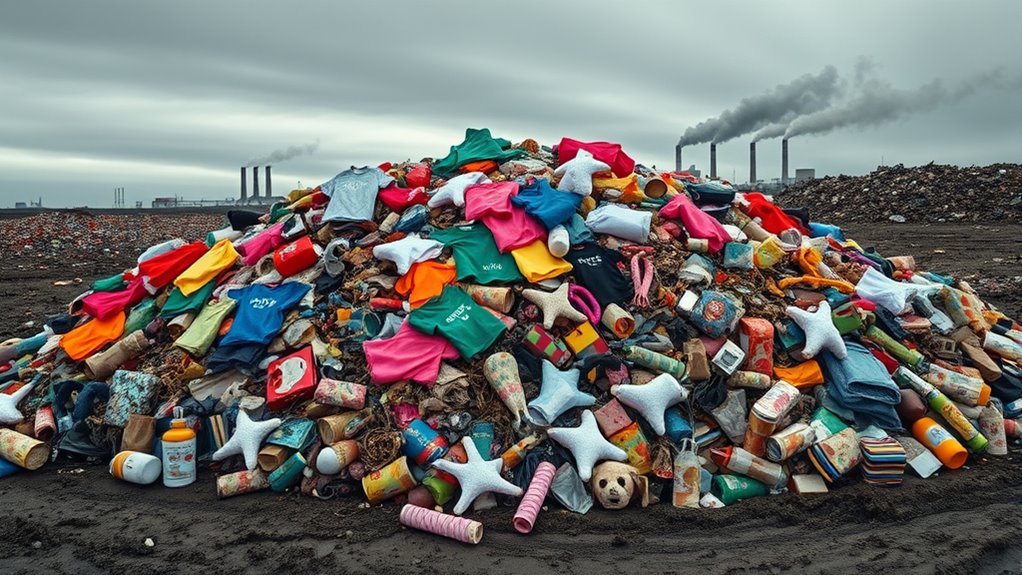
Have you ever wondered what happens to fast-fashion gift items after they’re given? Once gifted, these items often have a short lifespan, ending up in landfills or discarded quickly. The lifecycle begins with textile sourcing, where cheap materials are chosen to keep costs low. Unfortunately, this process often involves poor labor conditions, with workers facing unfair wages and unsafe environments. Fast-fashion brands prioritize rapid production to meet demand, which leads to shortcuts and low-quality garments. After disposal, these items contribute to environmental waste, as many aren’t biodegradable. Additionally, the low-quality materials used in fast fashion can release harmful chemicals during production and after disposal. The use of synthetic fibers in fast fashion further exacerbates environmental pollution, as they do not decompose easily. As a consumer, understanding this cycle highlights the hidden costs behind your gift choices. The journey from production to disposal reveals the often overlooked human and environmental impacts of fast-fashion gift items. Recognizing the environmental costs of fast fashion can encourage more sustainable consumption habits and support ethical brands.
Environmental Impacts of Fast-Fashion Manufacturing Processes

Fast-fashion manufacturing processes considerably harm the environment through energy-intensive operations and resource depletion. You may not realize that producing synthetic fibers, a staple in fast fashion, consumes large amounts of fossil fuels and water. This leads to significant water pollution, especially during dyeing and finishing stages. Here are some key impacts:
- Synthetic fibers release microplastics into oceans, harming marine life.
- Water pollution occurs from dye effluents containing toxic chemicals.
- High energy use accelerates carbon emissions, contributing to climate change.
- Overusing water resources strains local ecosystems and communities.
- The raw materials used in fast fashion often involve environmentally damaging extraction processes.
These processes accelerate environmental degradation, making fast-fashion a major contributor to ecological harm. Understanding these impacts helps you recognize the true cost behind your trendy gift items.
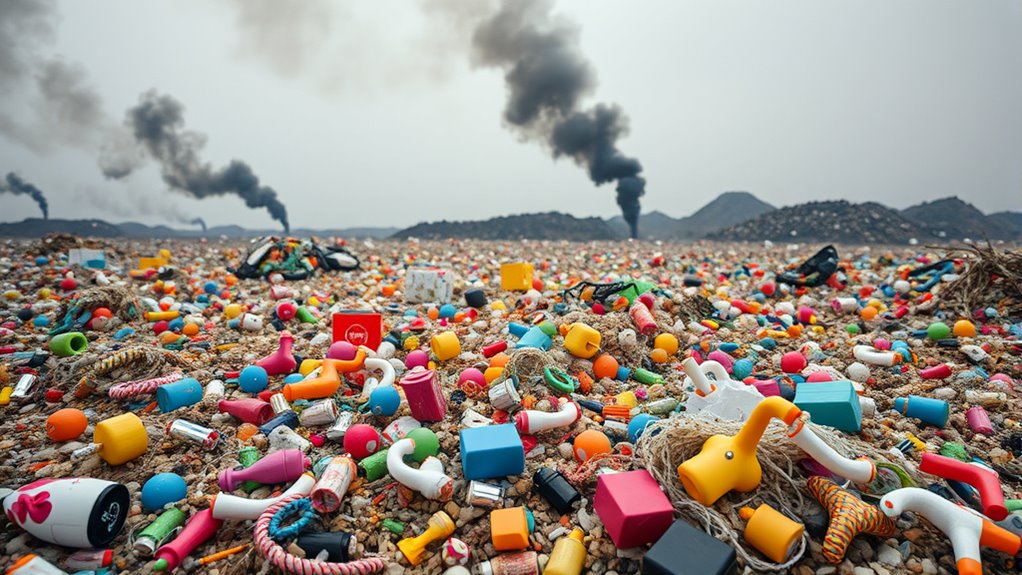
Although cheap gifts may seem like an easy way to save money, they often come with hidden environmental costs. When you discard these low-quality items, they contribute to textile waste that piles up in landfills, taking years to decompose. Furthermore, many inexpensive gifts are made with synthetic fibers that shed microplastics, polluting waterways. The production process also releases chemical runoff into nearby ecosystems, harming wildlife and contaminating water supplies. These chemicals can linger in the environment long after the gift is thrown away, creating a cycle of pollution that’s difficult to break. Additionally, the power consumption of producing and disposing of these items adds to their environmental footprint. By choosing more sustainable options, such as eco-friendly materials, you can help reduce this waste and pollution, making a positive impact on the planet and supporting environmentally responsible practices. Incorporating sustainable manufacturing practices further minimizes environmental damage throughout the supply chain.
The Role of Consumer Behavior in Sustainability Challenges
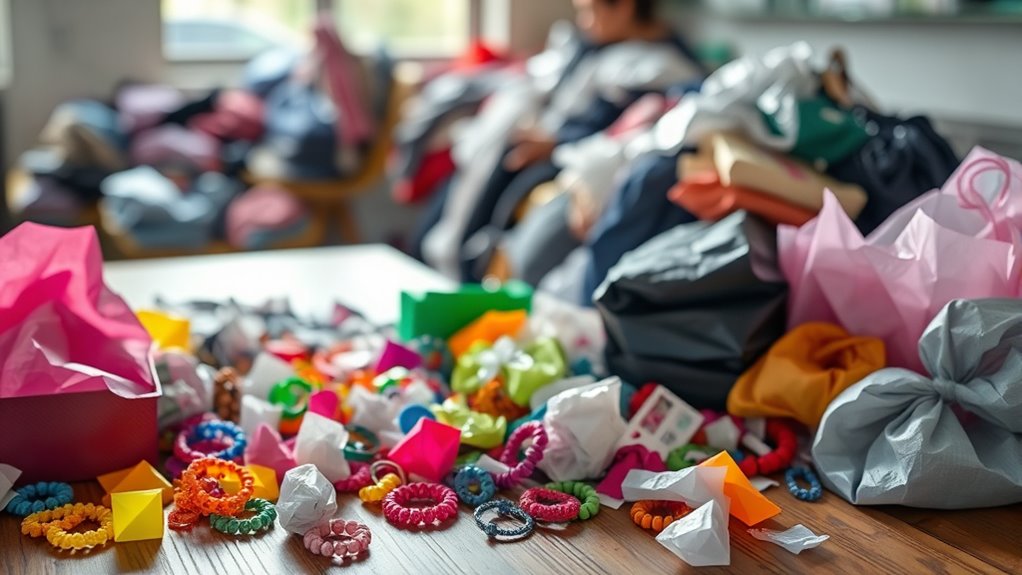
Your purchasing choices play a significant role in shaping the environmental impact of the fashion industry. By understanding your consumer habits, you can drive more sustainable practices. Here are four ways your behavior influences change:
- Choosing quality over quantity reduces waste and promotes durability.
- Supporting brands committed to ethical consumerism encourages responsible production.
- Avoiding impulsive buys helps cut down on fast-fashion waste.
- Educating yourself about sustainable materials pushes the industry toward eco-friendly options.
- Supporting organic and sustainably farmed products can also help mitigate environmental impacts associated with production practices such as those seen in the tea industry. sustainable farming practices
- Developing a growth mindset toward sustainability can inspire more conscious and impactful choices in your shopping habits.
- Researching brands’ certifications and sourcing can further ensure your purchases align with environmentally responsible standards.
Your decisions matter. When you prioritize ethical consumerism, you help shift the market toward more sustainable practices, reducing the environmental cost of fast-fashion gift items. Small changes in your behavior can lead to meaningful impact in addressing sustainability challenges.
Toward Eco-Friendly Alternatives and Responsible Gifting
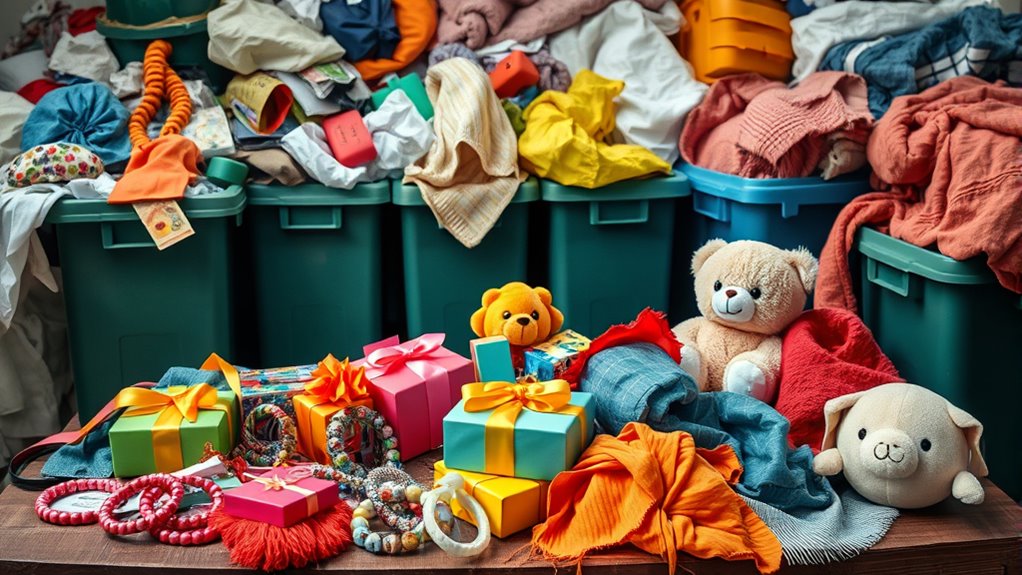
As consumers become more aware of environmental issues, choosing eco-friendly alternatives and practicing responsible gifting can substantially lessen the fashion industry’s ecological impact. Opt for gifts made with sustainable packaging, which reduces waste and energy use. Prioritize items from brands committed to ethical sourcing, ensuring fair labor practices and eco-conscious materials. You can also consider giving timeless, durable products instead of fast-fashion items. To help guide your choices, here’s a comparison:
| Aspect | Traditional Gift Items | Eco-Friendly Alternatives | Responsible Gifting |
|---|---|---|---|
| Packaging | Plastic, non-recyclable | Biodegradable, reusable | Sustainable packaging |
| Sourcing | Fast production | Ethical sourcing | Fair labor practices |
| Material Quality | Low durability | Long-lasting materials | Durable, timeless |
| Environmental Impact | High carbon footprint | Lower emissions | Conscious consumption |
| Cost | Often cheaper | Slightly higher | Invest in quality |
Choosing thoughtfully supports a greener, more ethical gift-giving culture.
Frequently Asked Questions
How Does Fast Fashion Contribute to Global Carbon Emissions?
Fast fashion notably boosts global carbon emissions by increasing your carbon footprint through rapid production cycles. When you buy fast fashion items, companies often source materials unsustainably, leading to deforestation and pollution. These quick-turnaround manufacturing processes use energy-intensive methods, releasing greenhouse gases. Your choices impact material sourcing and contribute to climate change, emphasizing the importance of mindful shopping to reduce your environmental impact and support more sustainable fashion practices.
What Are the Social Impacts of Fast-Fashion Manufacturing in Developing Countries?
You might not realize, but fast-fashion manufacturing in developing countries often relies on sweatshop labor, which can exploit workers and create unsafe conditions. It also leads to cultural erosion, as traditional practices and local industries get replaced by mass-produced items. This global demand for cheap clothing impacts these communities socially, stripping away their cultural identity and perpetuating inequality, all while providing affordable fashion to consumers worldwide.
Are There Certification Standards for Eco-Friendly Gift Items?
Did you know that over 400 eco-labels exist worldwide? Certification standards for eco-friendly gift items help you identify products that meet sustainable criteria. These standards guarantee responsible sourcing, ethical manufacturing, and minimal environmental impact. By choosing items with reputable eco labeling, you support environmentally conscious brands and reduce your carbon footprint. It’s a simple step that makes a significant difference, helping protect the planet for future generations.
How Can Retailers Promote Sustainable Gift Options Effectively?
You can promote sustainable gift options effectively by using sustainable marketing strategies that highlight eco-friendly features. Showcase products with eco-friendly packaging and emphasize their environmental benefits to attract eco-conscious shoppers. Use social media and in-store displays to educate customers on sustainability efforts. Offering incentives for choosing eco-friendly gifts and partnering with certified eco-friendly brands can also boost awareness and encourage more sustainable purchasing choices.
What Policies Could Reduce the Environmental Footprint of Fast-Fashion Gifts?
Prioritizing policies that promote responsible production, you can greatly reduce fast-fashion gift footprints. Implementing strict standards for sustainable packaging and enforcing fair labor practices ensures ethical and environmentally friendly practices. Supporting legislation that incentivizes eco-conscious materials and transparent supply chains helps hold brands accountable. These policies foster a future where fast-fashion gifts are both fabulous and environmentally friendly, encouraging consumers to choose ethically made items without compromising quality or style.
Conclusion
Every gift you choose fuels a cycle of environmental harm, like adding fuel to a blazing fire. By being mindful and opting for eco-friendly alternatives, you hold the power to turn the tide. Your choices can break this chain, transforming gifts from harmful to sustainable. Remember, small acts ripple outward—your responsible gifting can be the spark that ignites a greener future for all.
